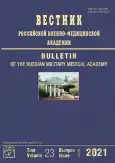Topographical, anatomical and neurosurgical aspects of "end-to-side" nerve repair
- Authors: Nisht A.Y.1, Fomin N.F.1, Orlov V.P.1
-
Affiliations:
- Military medical academy of S.M. Kirov
- Issue: Vol 23, No 1 (2021)
- Pages: 121-128
- Section: Experimental trials
- URL: https://journals.rcsi.science/1682-7392/article/view/63628
- DOI: https://doi.org/10.17816/brmma63628
- ID: 63628
Cite item
Abstract
The article presents the results of a comprehensive anatomical and experimental study of individual variability in the structure and topography of motor branches of peripheral nerves in relation to the justification of methods for selective reinnervation of tissues by the "end-to-side" neurorrhaphy. It was found that relatively longer branches of peripheral nerves with a small number of connecting inter-arm collaterals characteristic of narrow and long limbs create conditions for less traumatic mobilization of motor branches. In cases with relatively wide and short extremities mobilization of peripheral nerves is complicated by the presence of a large number of collateral branches and intra-trunk connections, which are often damaged when separate bundles that make up the mobilized branches of the donor or recipient nerve are isolated from the main nerve trunk. It has been shown that potential recipient nerves should be motor branches of peripheral nerves, the preservation of which is of fundamental importance for the function of the corresponding segment of the limb. To create conditions conducive to selective reinnervation of functionally significant muscle groups of the upper limb, we have developed, justified from anatomical positions, and tested in an experiment on anatomical material methods for connecting the distal motor branches of peripheral nerves by the "end-to-side" neurorrhaphy. The main idea of accelerated recovery of the thumb opposition in injuries of the median nerve is to reinnervate the muscles of the elevation of the I finger due to nerve fibers that are part of the deep branch of the ulnar nerve. For this purpose, surgical techniques have been developed for connecting the recurrent motor branch of the damaged median nerve mobilized at the level of the wrist with the edges of a surgically formed perineurium defect on the lateral surface of the bundles that make up the deep branch of the ulnar nerve. In another clinical situation, in patients with radial nerve injuries, for the muscle reinnervation, а method is proposed for neurotisation of the deep motor branch of the radial nerve by the end-to-side suture to the lateral surface of the median nerve. We assume that performing the "end-to-side" nerve suture at the level of the base of the hand in the cases of proximal damage to the median nerve will reduce the time of reinnervation of the muscles of the thumb elevation by 400–450 days. Transposition of the deep branch of the damaged at the proximal level radial nerve with "end-to-side" neurorrhaphy to the median nerve — by 250–300 days (based on the total length of the shoulder and forearm, which is about 50 cm and the rate of regeneration of nerve fibers 1 mm per day). Accordingly, with higher injuries (brachial plexus), the gain in the time of reinnervation of the distal segments will be even greater. In our opinion, the results can be used as a basis for further clinical research on the development of methods for selective tissue reinnervation in cases with isolated injuries of the peripheral nerves.
Full Text
##article.viewOnOriginalSite##About the authors
A. Y. Nisht
Military medical academy of S.M. Kirov
Author for correspondence.
Email: nachmed82@mail.ru
candidate of medical sciences, assistant professor
Russian Federation, 6G, Akademika Lebedeva street, Saint-Petersburg, 194044Nikolay F. Fomin
Military medical academy of S.M. Kirov
Email: fominmed@mail.ru
doctor of medical sciences, professor
Russian Federation, 6G, Akademika Lebedeva street, Saint-Petersburg, 194044Vladimir P. Orlov
Military medical academy of S.M. Kirov
Email: vladimir.rlv@rambler.ru
doctor of medical sciences, professor
Russian Federation, 6G, Akademika Lebedeva street, Saint-Petersburg, 194044References
- Bersnev VP, Kokin GS, Izvekova TO. Anatomo-fiziologicheskie osobennosti zabolevanij i povrezhdenij perifericheskih nervov. In: Prakticheskoe rukovodstvo po hirurgii nervov. Moscow; 2017. P. 15–32. (In Russ.)
- Vishnevskij VA. Reasons and diagnostic errors in cases of the peripheral nerves of extremities injuring. Zaporozhskij medicinskij zhurnal. 2014;4(85):50–55. (In Russ.)
- Goven’ko FS. Hirurgija povrezhdenij perifericheskih nervov. Saint-Petersburg: Feniks; 2010. (In Russ.)
- Odinak MM, Zhivolupov SA, Fedorov KV, Lifshic MJu. Distortion of conductivity in conditions of traumatical neuropathies (pathogens, clinical syndromes, treatment and diagnostics). Voenno-medicinskij zhurnal. 2008;2:28–39. (In Russ.)
- Zhivolupov SA, Gnevyshev EN, Rashidov NA, Samarcev IN. Neuroplastic patterns of functions restoration in case of traumatic neuropathies and plexopathies. Vestnik Rossijskoj Voenno-medicinskoj akademii. 2015;1(49):81–90. (In Russ.)
- Khodzhamuradov GМ, Davlatov АA, Ismoilov MM, et al. Prognosis of motor results of nerve grafting of upper extremity. Vestnik Tambovskogo universiteta. Serija: Estestestvennye i tehnicheskie nauki. 2012;3:898–900. (In Russ.)
- Bajtinger VF, Bajtinger AV. End-to-side nerve suture: strategy of "obtaining" axones from the intact nerve (part I). Voprosy rekonstruktivnoj i plasticheskoj hirurgii. 2013;2(45):6–12. (In Russ.)
- Millesi H, Schmidhammer R. End-to-side coaptation – controversial research issue or important tool in human patients. Acta Neurochir. 2007;100:103–106.
- Lundborg G, Zhao Q, Kanje M, et al. Can sensory and motor collateral sprouting be induced from intact peripheral nerve by end-to-side anastomosis? J Hand Surg (Brit). 1994;19:277–282.
- Viterbo F, Teixeira E, Hoshino K, Padovani CR. End-to-side neurorrhaphy with and without perineurium. Sao Paulo Med J. 1998;116:1808–1814.
- Viterbo F, Brock RS, Maciel F, et al. End-to-side versus end-to-end neurorrhaphy at the peroneal nerve in rats. Acta Cir Bras. 2017;32(9):697–705. doi: 10.1590/s0102-865020170090000002
- Yan JG, Shen FY, Thayer J, et al. Repair of the musculocutaneous nerve using the vagus nerve as donor by helicoid end-to-side technique: an experimental study in rats. J Neurosci Res. 2017;95(12):2493–2499. doi: 10.1002/jnr.24074
- Nisht AY, Fomin NF, Imelbaev AI, Mikulich AA. Restoration of motor innervation by the "end-to-side" neurorraphia: experimental modeling and clinical and instrumental control of reinnervation. Journal of experimental and clinical surgery. 2020;2(46):24–33. (In Russ.)
Supplementary files








